James Reed, achieved worldwide acclaim with his Oscar-winning Netflix documentary My Octopus Teacher, the director’s latest offering for the streamer is an epic four part natural history series CHIMP EMPIRE.
In the series, produced by Underdog Films and Keo Films, the director and production team behind Rise of the Warrior Apes, return to the world of the Ngogo chimps, the largest chimpanzee society ever discovered to capture them as they navigate the complex social politics, family dynamics and dangerous territory disputes. Over the course of the four remarkable episodes the team captured once-in-a-lifetime events within the chimp society that reflect our own human society. The series took over a year to shoot and is narrated by Academy Award® winner Mahershala Ali.
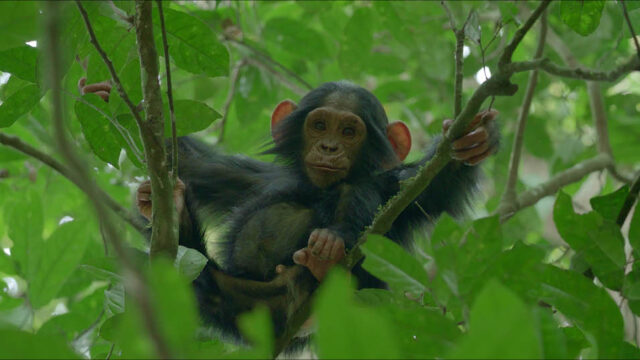
Filming under the lush canopies of Uganda’s Ngogo Forest, Reed and his crew embedded into Chimp society for over 400 days. With the invaluable help of Professor John Mitani, the other scientists at Ngogo and field trackers who have lived alongside this chimp community for the last 25 years, the team watched the story unfold from within this sophisticated political and familial structure. But Reed had no way to know that the year ahead would bring some of the most tumultuous battles and dramatic changes in the group’s history.
It took an unprecedented effort to document the lives of the Ngogo chimpanzees in such detail. Reed had to embed two crews, including two camera ops each, within the two separate groups of chimpanzees for over a year and a half. Working closely with the Ngogo scientists, especially Professor John Mitani; the work was made even more difficult because it was done during the COVID19 pandemic requiring production to set up a quarantine camp where they could be regularly tested before going to live in the jungle for the duration of the shoot alongside the scientists. Living and working within the scientist’s camp, the team had to be as low impact as possible, using solar panels where possible and small generators to charge batteries and to dry out camera equipment. They reduced kit to the absolute minimum, walking into the jungle on foot and living off locally sourced food.
The dedication and hard work paid off as they were able to film unique events at a pivotal time in the long-term study of the chimpanzees, capturing footage that depicted things even the scientists hadn’t witnessed in over 30 years studying these wild chimpanzees.
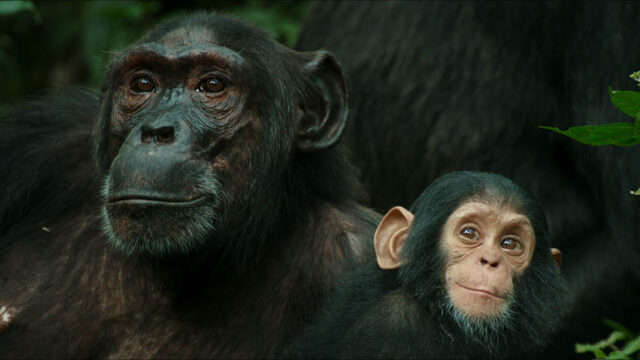
JAMES REED
Some years ago, I did a film about the Ngogo chimps and the scientists who study them [Rise of the Warrior Apes]. It tracked their story from when they were first discovered 25 years ago, and how the scientists learned about their unique qualities. Following that film, there was internal conflict between the chimps ruling the group, and they split into two distinct social groups. They began to lead separate lives, and whenever they met, it was hostile. The scientists were telling me all this news: “You won’t believe it, the Ngogo group has finally split. We have no idea what will happen now. Will they reunite? Will they go to war? We just don’t know” We’d reached an historic moment. It was going to be new for science, and it also provided a unique opportunity to film this dramatic situation in the forest.
Our first shoot was in January of 2021, we had six months to prepare. I knew I wanted to make something that was a truly character driven, something that would draw the audience into who these chimps really are, but capturing the emotion, politics, and drama of their lives was going to be very challenging. Using the detailed research provided by Professor John Mitani and his team was vital in our preparation. Writer Matt Houghton and I were able to “cast” the series from the 200 plus chimps based on years of information that provided us with their backstories and a sense of what everyone might be up against in our filming period.
We wanted to follow chimps who were likely to experience some change and whose stories would give us a clear cross section of their society. We knew that our focus could (and should) change with unpredictable events but it was a great place to start. By combining filming our “cast” and with the flexibility to shift focus when the opportunity arose, we were able to witness their stories unfolding before us like a Shakespearean drama.
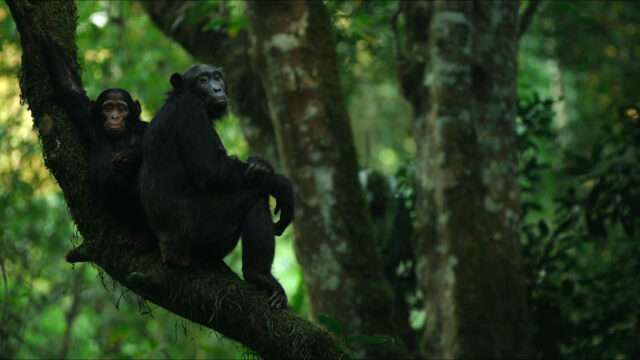
Having worked previously with the Ngogo scientists and chimps, we had a shorthand. We knew the conditions of the jungle and that you can’t spy on chimps. It’s not like being in a safari vehicle with a camera and a long lens, in the forest if you’re not within 20 meters of the chimps you often can’t even see them. To follow them, you must do so from a close but respectful distance. Due to the need for this proximity, they always know where you are, so the crew needed to be present, and comfortable in the group.
It was by combining the meticulous scientific research along with the employment of new technology and filming techniques that allowed us to capture the action and the heart of these stories. We were inspired by the scientist Prof David Watts who had for years been using a mini high 8 dv handheld camera to capture visual research of the chimps and who had often been present for moments that no crew had ever filmed.
The choice of team and camera equipment was therefore vital, and both were made up of unexpected choices in lots of ways. Our crew all had experience in remote environments and were very talented, but not all were experienced in natural history filming, but did have experience filming unpredictable human stories in remote locations. The crew was also young, extremely fit, passionate, and dedicated to the philosophy that if we wanted to tell the chimps stories, we’d have to be able to keep up and react quickly.
That was to be essential for filming the chimps as a true observational documentary and as a Director I couldn’t be too prescriptive and gave the crew autonomy for their own creativity in the field as they needed to use their instincts and skills to react to the storylines as they happened.
In terms of equipment choices there were many factors we had to consider and working very closely with one of theDirectors of Photography, Ben Sadd, we came up with the most light-weight, ergonomic kit combinations we could to allow the crew to be as agile as possible in the forest whilst delivering the high production values and amazing imagery needed for a premium Netflix show in 4K.
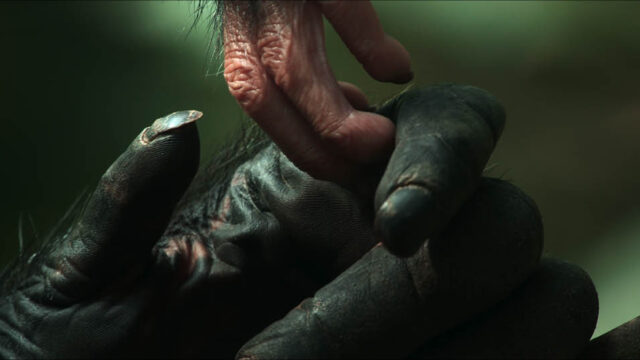
We used two relatively light weight 4K cameras the Canon C300 and the Canon C70, lightweight tripods, small gimbals and even our longest lens was a Canon CN10 which is a lot smaller and lighter than standard natural history kit.
We had to make a lot of compromises, but it allowed us to capture much more of the drama and created a very innovative visual language for the series. For instance, high quality hand-held camera work allowed us to capture more of the story, but it’s rarely used in traditional Natural history. In doing so it makes the series feel much more contemporary, and closer in style to a drama or premium documentary.
The crew lived alongside the scientists, in a small camp in the middle of a very remote area in Uganda, in the middle of the Ngogo chimps’ territory. There’s miles and miles of rainforest in every direction. Every day we would go with the scientists and trackers first thing in the morning and find the chimps, they often make a lot of noise, so it was usually quite straightforward to find them. The difficulty was keeping up with them because they move over huge territories through rugged terrain. It was therefore not unusual for our crew to cover 20km a day through the forest. To cover the action we had two teams, with two camera operators in each team, and we would tag team those teams in and out virtually continuously for about 450 days allowing us to record the chimps for as much of their lives every day for as long as they were awake.
By literally walking in the footsteps of scientists, we had a much better understanding of what the chimps were doing, were about to do and meant we could interpret the behaviour we had captured each day. Their knowledge and insight enabled us to make a much better series. Several of the Ugandan trackers joined the camera team as camera operators. One of the trackers, Diana, shot some amazing parts of the story. She knew the chimps better than we did, she was fitter than we were, and she could predict their behaviour better – that gave her unique strength as a camera operator on our team.
A huge amount of effort and patience was required to make this series but thankfully that effort seems to have paid off. I am pleased to say that I think everyone involved found it rewarding on a personal level too. Spending time with the Ngogo chimps and getting to experience their lives is a privilege. Chimpanzees are our closest living relatives and understanding who they are can provide insights into who we are, but when you get to know them, the chimps become much more than that. They have their own fascinating lives that are separate and distinct from ours and its impossible not to become very attached to them. I hope we can give the viewer some of that same experience and I hope that motivates us all to help protect and conserve these endangered animals and the forests where they live.
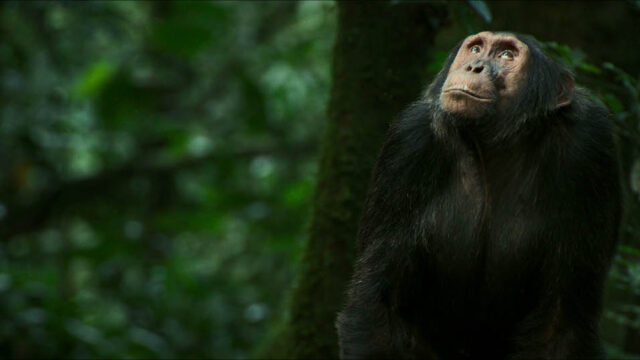
GLOBAL NETFLIX RELEASE DATE: April 19, 2023
Episodes: 4 x 45 minutes
Director: James Reed
Production Companies: Underdog Films and Keo Films
Executive Producers: For Underdog Films: James Reed; for Keo Films: Matt Cole
Series Producer: Callum Webster
Jon Creamer
Share this story


















